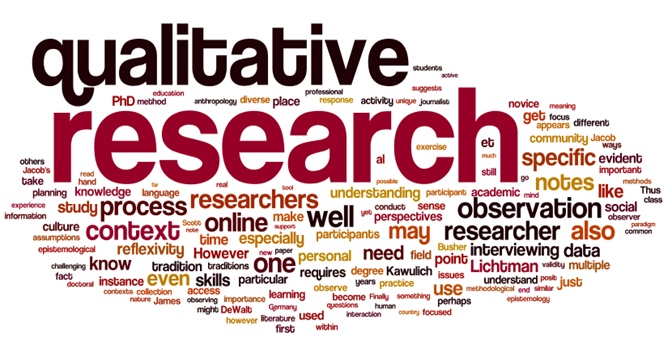Image source: lynn-library.libguides.com
Qualitative research is the collection, analysis, and interpretation of data on the underlying problem. It helps you develop ideas or hypotheses to a problem. It gathers non-numerical data or “reasons behind a certain behavior”.
Qualitative research focuses on evaluating, clarifying, and understanding the respondent’s behavior and attitude. Let’s take a look at the pros and cons of using qualitative research in collecting raw data.
Pros:
1. A small sample: The research is carried out on a small group of respondents to provide fast results at a low cost.
2. Flexible: You can interview a small group of respondents at different locations and timing. You don’t have to worry about interviewing a large number of people at the same time.
3. Unrestricted interviews: Interview questions used to collect data are not restricted to specific questions and the researcher can guide or redirect respondents.
4. Revision of the research framework: The new information gathered through the research can be used to change the research framework and direction.
5. Detailed examination: It requires you to examine an area of research in detail and in more depth than quantitative research.
6. Taps respondent’s creativity: Qualitative research questions are open-ended, dynamic and can help in tapping the respondent’s creativity as well as get more ideas by interacting with them.
7. Source of more ideas: Qualitative research provides a rich source of more formative ideas which can be evaluated on the topic.
8. Powerful information: The collected and analyzed data based on human experience is more powerful and more compelling than the quantitative data.
9. Explain customer’s attitude: Through qualitative research, you can get an explanation of events that happen outside a certain predictive matrix from the previous research. This helps to understand the customer’s attitude and behavior.
10. Open-ended process: Qualitative research enables you to get superficial responses, rational thoughts, and emotional responses from the respondent. The emotional response influences one’s decision and behavior.
Cons:
1. No generalization: Once you collect data from the respondents, you can’t generalize the findings like in quantitative research. Qualitative research doesn’t allow you to use the findings as to the basis for representing a wide audience or the public.
2. Require industry-related expertise: It is dependent on the interviewer’s skills and experience. Lack of industry-related expertise may lead to the collection of inaccurate data.
3. Time-consuming: The volume of data collected, the analysis process, and the interpretation of data are very time-consuming. It is also time-consuming to characterize findings in visual form.
4. Difficult to quantify: It is very difficult to quantify the number of respondents who answered one way or the other. You cannot easily create a solid statistic on the number of respondents.
5. Trust: A lot of trust and patient is needed for the researcher to gather data and draw together the unseen data from the respondent. This ensures unseen data doesn’t disappear.
6. Not accepted: Qualitative research is not well understood or accepted in the scientific community as quantitative research. More people rely on quantitative data than on qualitative data.
7. Subjective data: The data collected is highly subjective due to the individual perspectives of the researchers. A single researcher can collect data that is deemed pointless and unimportant by another researcher. This can lead to inaccurate and unreliable data.
8. The rigidity of data: Data collected is based on individual perspectives making it difficult to prove the rigidity of the information collected.
9. Require repetitive research periods: Qualitative research rely on small sample size and this creates a problem for small business facing challenges. The small sample is not representative of a large portion therefore, a follow-up should be done with a large sample size to get accurate data.
10. No exact matches: It is not easily repeated and you can’t get the exact responses as the previous research compared to the results of quantitative research.


